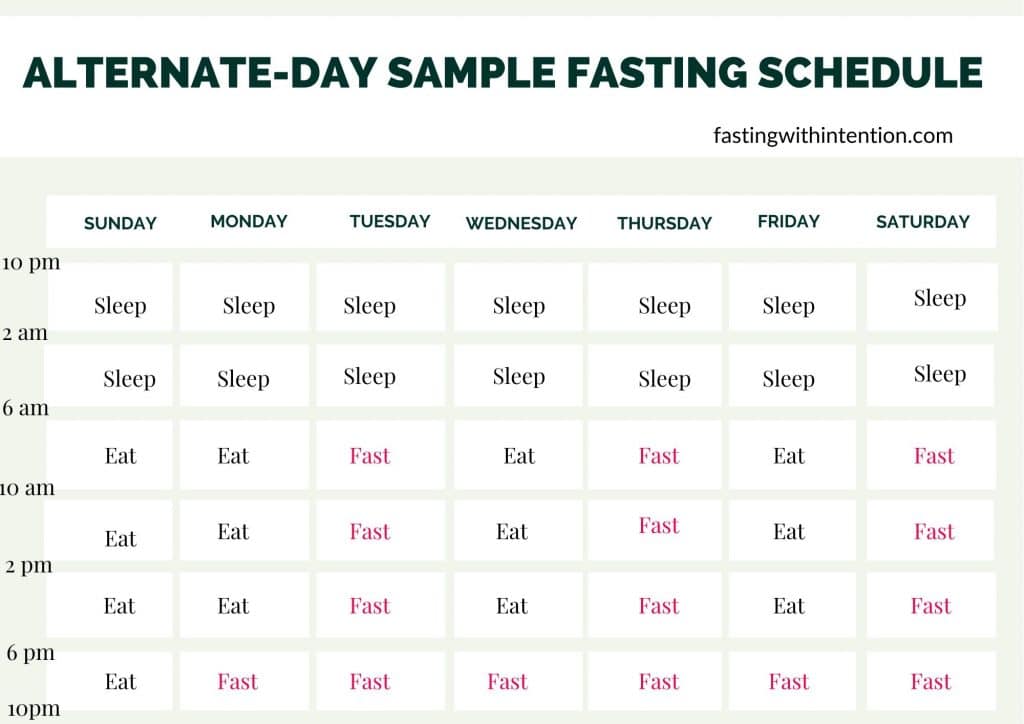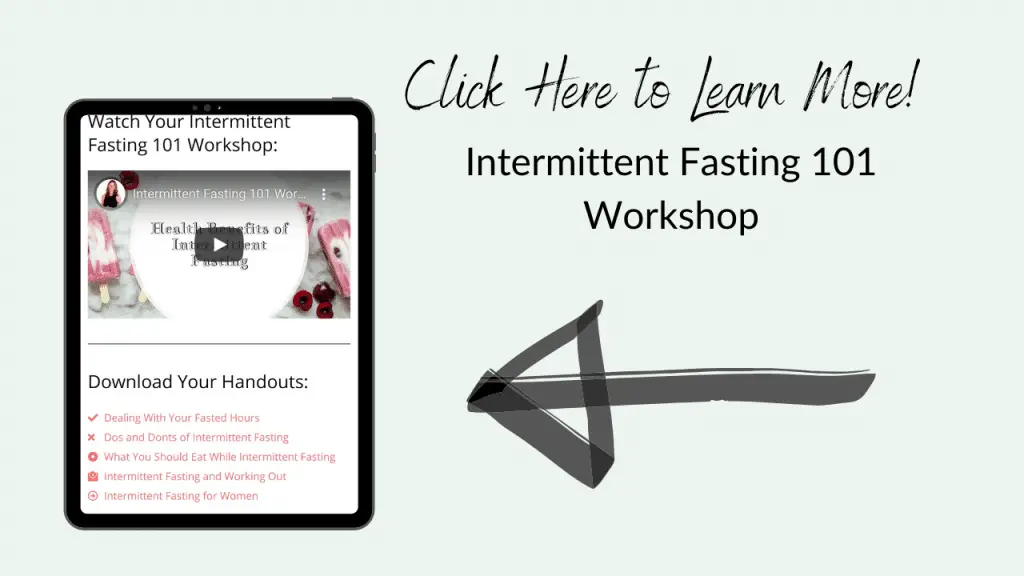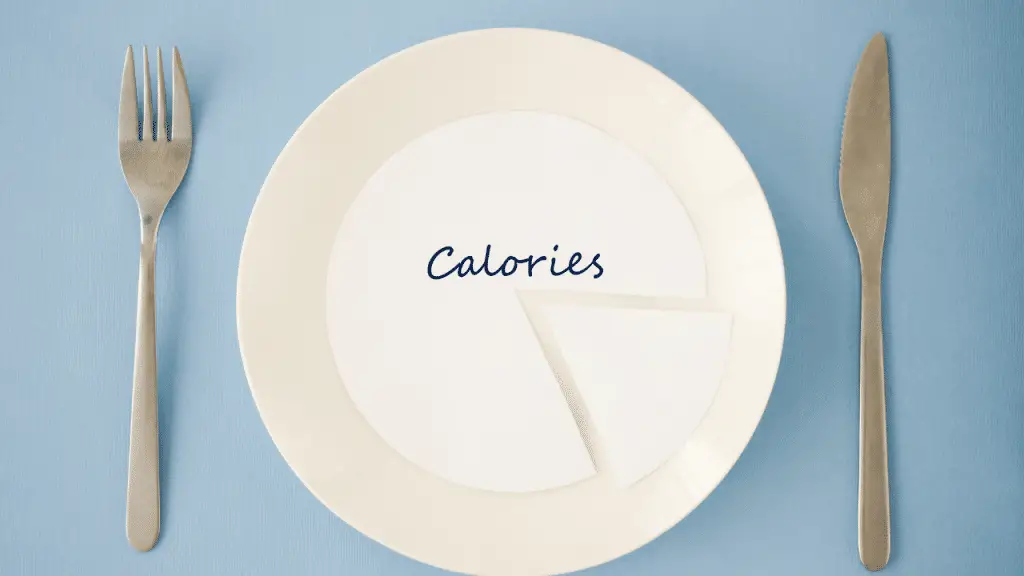OMAD (or One Meal a Day) has to be the most popular intermittent fasting method right now. It has allowed many women to heal their bodies and lose weight. On the other hand, I also hear from many women who feel discouraged because OMAD didn’t help them how they thought it would. When they ask me what to do, I recommend alternate-day fasting. After reading this post, you will understand everything about alternate-day fasting and why it may work better than any other type of intermittent fasting.
To learn more about OMAD, read OMAD vs. 2MAD: Which Intermittent Fasting Method Should You Choose?

What Is Alternate-Day Fasting
Typically, alternate-day fasting is fasting for 36 hours twice a week. So, say you have dinner on Monday at 6 pm and start fasting at 6:30 pm. You will fast overnight, the next day, and the next night. Wednesday morning at 6: 30 am is the end of your fasting window, which comprises 12 hours the first night, 12 hours the next day (on Tuesday), and 12 hours the next night (until 6:30 am).
Modified Alternate-Day Fasting
Another option is to eat a small meal (around 500 calories) 24 hours after the beginning of your fast, go to bed, and resume normal eating the next morning. With that scenario, you are still reaping the benefits of a 24 hour-fast and of a severe calorie restriction for 36 hours, but you may find your fast more doable.
Alternate-Day Fasting Schedule
A common Alternate-Day Fasting Schedule involves fasting every second day like so:

This sample alternate-day fasting schedule is from my post Alternate-Day Fasting for Weight Loss: Is It Safe for Women? You will notice that it includes three fasting days a week. That’s an effective option for sure, but it may be too intense and unnecessary.
Keep in mind that in my post Alternate-Day Fasting for Weight Loss: Is It Safe for Women?, I suggest you follow this sample alternate-day fasting schedule for only one or two weeks a month at the beginning of your menstrual cycle. This recommendation is because many women need extra carbs and nourishment during the last week leading up to their menstruation. For this reason, fasting experts such as Dr. Mindy Pelz encourage women to practice intermittent fasting and the keto diet on a cyclical basis.
If you were to pick only one or two 36-hour fasting windows a week, you could try sticking to your schedule for the whole month to see how you feel.

Creating Your Alternate-Day Fasting Schedule
Fasting for 36 hours can seem a bit intimidating. It does for me, anyway. Here’s how I would work up to it gradually:
- Start the first week of your cycle with a modified alternate-day fasting plan only twice during the week. Remember, modified alternate-day fasting involves eating 500 calories at dinner on your “fasting” day.
- How do you feel at the end of the week? If your goal is weight loss, did you lose any weight? You can stay at this stage until you feel ready for more if you feel great and have achieved a weight loss of 1 or 2 lbs.
- If you want to lose weight and haven’t even lost 1 lb, go for a full fast on your fasting days, but again, stick to a schedule that requires you to fast only 2 days a week. You should see some encouraging results after a week or two. If so, stick to this alternate-day fasting schedule (including before your menstruation if you can handle it).
- Keep experimenting with switching days and modifying your schedule as needed. We will talk about possible side effects you may experience and about how to adjust your alternate-day fasting schedule further at the end of this post.
Don’t forget to watch my Intermittent Fasting 101 Workshop for further help with implementing intermittent fasting.

Why Alternate-Day Fasting Works
Alternate-day fasting is one of the most promising intermittent fasting methods for two reasons:
- It’s not done daily, which keeps your body guessing and gives you more food freedom.
- The longer fast gives you more healing benefits.
On top of that, the longer fast helps you get deeper into ketosis, which will help you for the remainder of the week. In this section, I am going to compare alternate-day fasting to some other common weight-loss regimens, and we are going to discuss how the benefits of alternate-day fasting extend beyond weight loss,
Alternate-Day Fasting for Weight Loss
Weight loss is usually one of the main goals when people start experimenting with intermittent fasting, so let’s discuss why alternate-day fasting works so well for weight loss.

Alternate Day Fasting Vs. Calorie Restriction
Alternate-day fasting tends to be more effective than calorie restriction for weight loss. Weight loss requires a calorie deficit even when you practice intermittent fasting, which also goes for alternate-day fasting. However, alternate-day fasting enables you to create a calorie deficit without trying. We won’t be having the calories-in-calories-out discussion in this post. Read my post How Long Does It Take to Lose 20 lbs? if you would like to dig deeper. What we are going to do is compare the mechanism of calorie restriction only with alternate-day fasting.
Studies have found that alternate-day fasting may be superior to calorie restriction for weight loss, and that’s the case for two main reasons:
- Your body will undergo some physical adaptations that will facilitate weight loss.
- Counting calories is far from being an exact science.

Ketosis
The most promising aspect of alternate-day fasting is that the longer fasting window will allow you to achieve deeper ketosis. In turn, this will naturally decrease food cravings and calorie consumption. For example, it’s interesting that participants in this study did not want to overcompensate during feeding days, which is explained by the fact that ketone levels remained elevated even on feeding days. I don’t know about you, but I find that pretty exciting!

The Problem With Calorie Restriction
Calorie restriction is very hard to sustain for most people. On one hand, we often tend to underestimate how much we eat. Many people think they are eating a certain number of calories when, in fact, they are consuming a lot more. Secondly, the calorie restriction necessary for weight loss would be around 25% (500 calories a day to achieve a weight loss of 1 lb a week). Reducing your calorie intake by 25% will make you feel hungry. Your body won’t get into ketosis, which helps reduce your appetite, so you will always feel hungry, trying to maintain a sufficient calorie deficit. The advantage of intermittent fasting is that hunger is temporary, and you know it. Moreover, achieving ketosis will reduce your desire to eat.

Alternate-Day Fasting Vs. OMAD
I wanted to briefly touch on OMAD because OMAD (or One Meal a Day) is so popular, and it’s one of the intermittent fasting methods with a longer fasting window. Many women achieve the results they want through OMAD. However, some women don’t, or they hit a plateau after a while. In that case, I often recommend alternate-day fasting. Here’s why:
- Alternate-day fasting keeps your body guessing. Sometimes, when you hit a plateau, all you need is to change things up. Your body is incredibly efficient at adapting to whatever food is available or whatever eating pattern you implement. Since alternate-day fasting is an intermittent fasting method that gives you days of feasting, it gives you that extra element of unpredictability.
- Alternate-day fasting will help you achieve deeper ketosis. On the OMAD diet, you will be fasting for 23 or 24 hours each day. For many, that’s long enough to allow your body to produce enough ketones to reduce your appetite and feel amazing. However, some women may need longer. If OMAD isn’t working, then alternate-day fasting may help.

Healing Benefits of Alternate-Day Fasting
Healing your body will help you feel your best to fulfill your dreams and help with weight loss. Here are some health benefits you may experience when practicing alternate-day fasting:
- Reduced inflammation
- Improved thyroid function
- Improved metabolic health
- Increased longevity
Sounds pretty promising, doesn’t it?
Potential Risks of Alternate-Day Fasting
According to this study, alternate-day fasting is safe to practice for several months, but I don’t want to make light of the potential health risks that you may incur from alternate-day fasting. You should be aware of these risks. If you notice adverse health effects, scale back.

Malnutrition
It should be no surprise that eating less may contribute to inadequate nutrition. In our current food supply system, getting enough nutrients from food alone can be challenging when you get three square meals a day! Imagine when you are substantially decreasing your caloric intake! I have been a firm believer in supplementation for years, even before experimenting with intermittent fasting. I suffered from frequent headaches, allergies, and chronic fatigue for over a decade despite eating a varied whole-food diet. I discovered I was vitamin D deficient, so supplementing with vitamin D3 made a big difference. I also noticed that taking a histamine blocker and a superfood shake improved my energy level and reduced my allergies.
All that to say that you need to pay attention to how your body is reacting. Are you tired, getting sick more often, losing hair, or feeling moody? It may be time to take a step back. If you notice any adverse health effects, it’s time to re-evaluate. Focus on nourishing your body with nutrient-dense foods. Read Intermittent Fasting for Weight Loss: 7 Tips to Help you Achieve the Results You Want for further guidance.
Eating Disorders
Fasting is never recommended for those who struggle with eating disorders. That should go without saying, but I still get the occasional troll who wants to point that out.

Alternate Day Fasting for Weight Loss Video
In Summary
Alternate-day fasting may not be the best option for beginners as the longer fast may be more demanding and stressful. However, the rewards are great, and you may find they are worth the effort. If you have been struggling with losing weight with intermittent fasting, alternate-day fasting is the most promising option.





